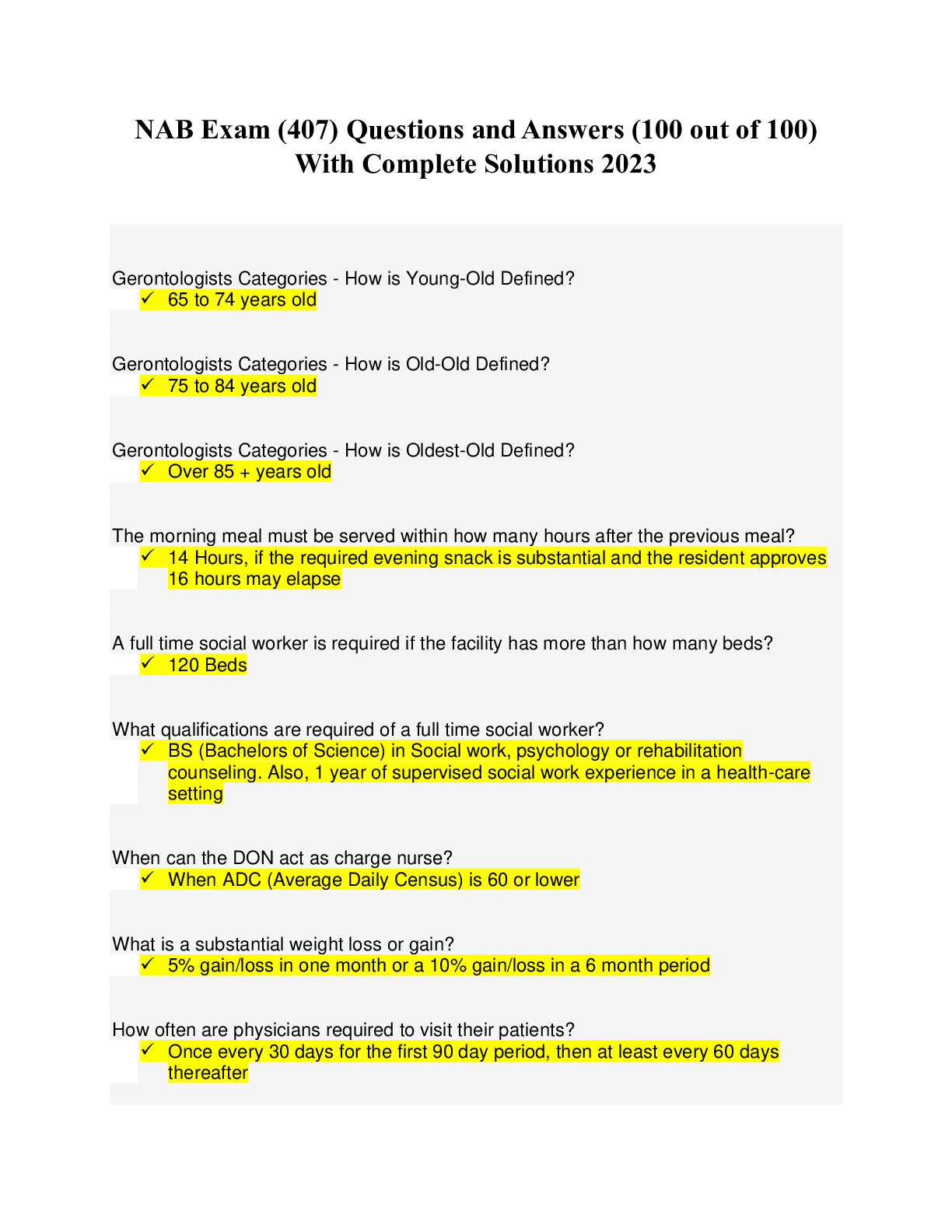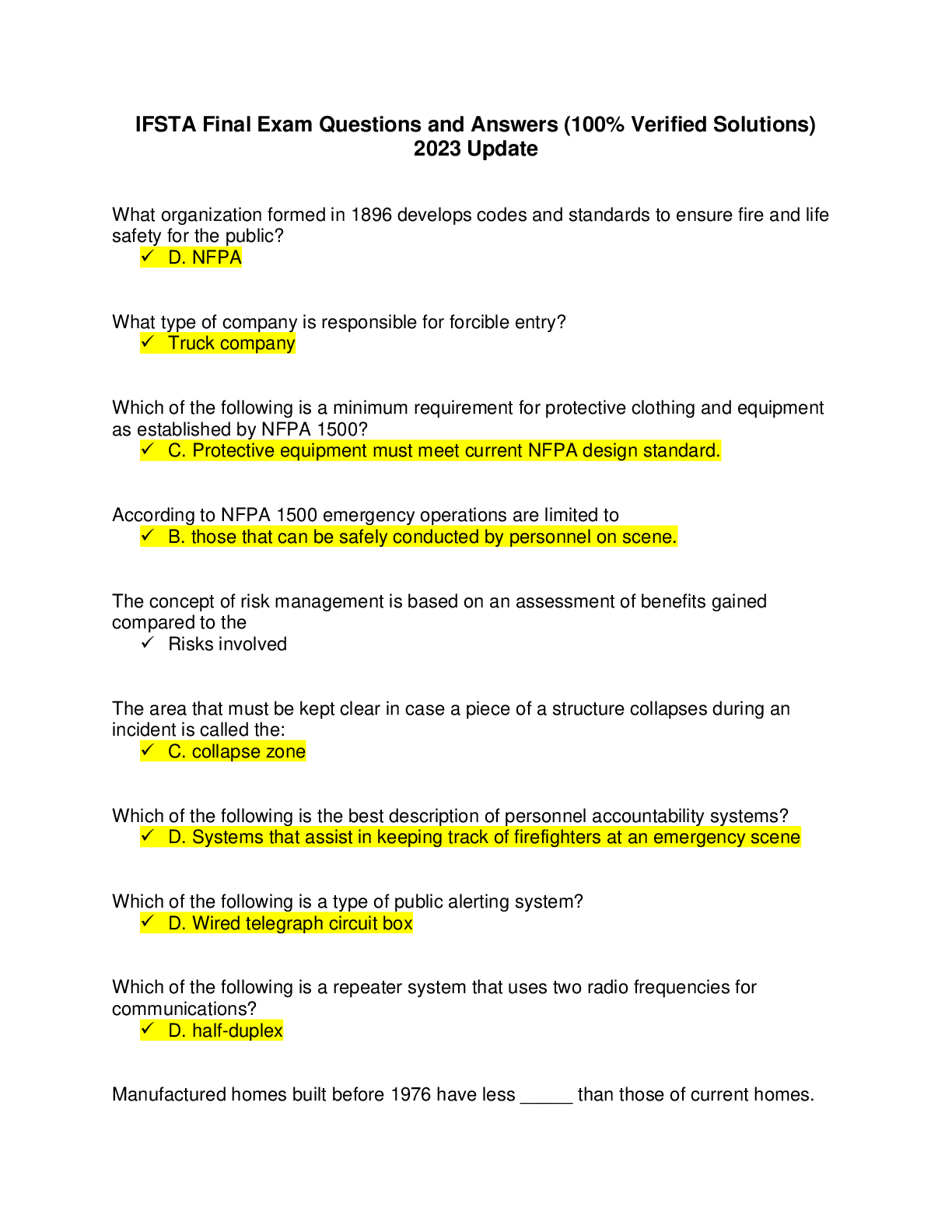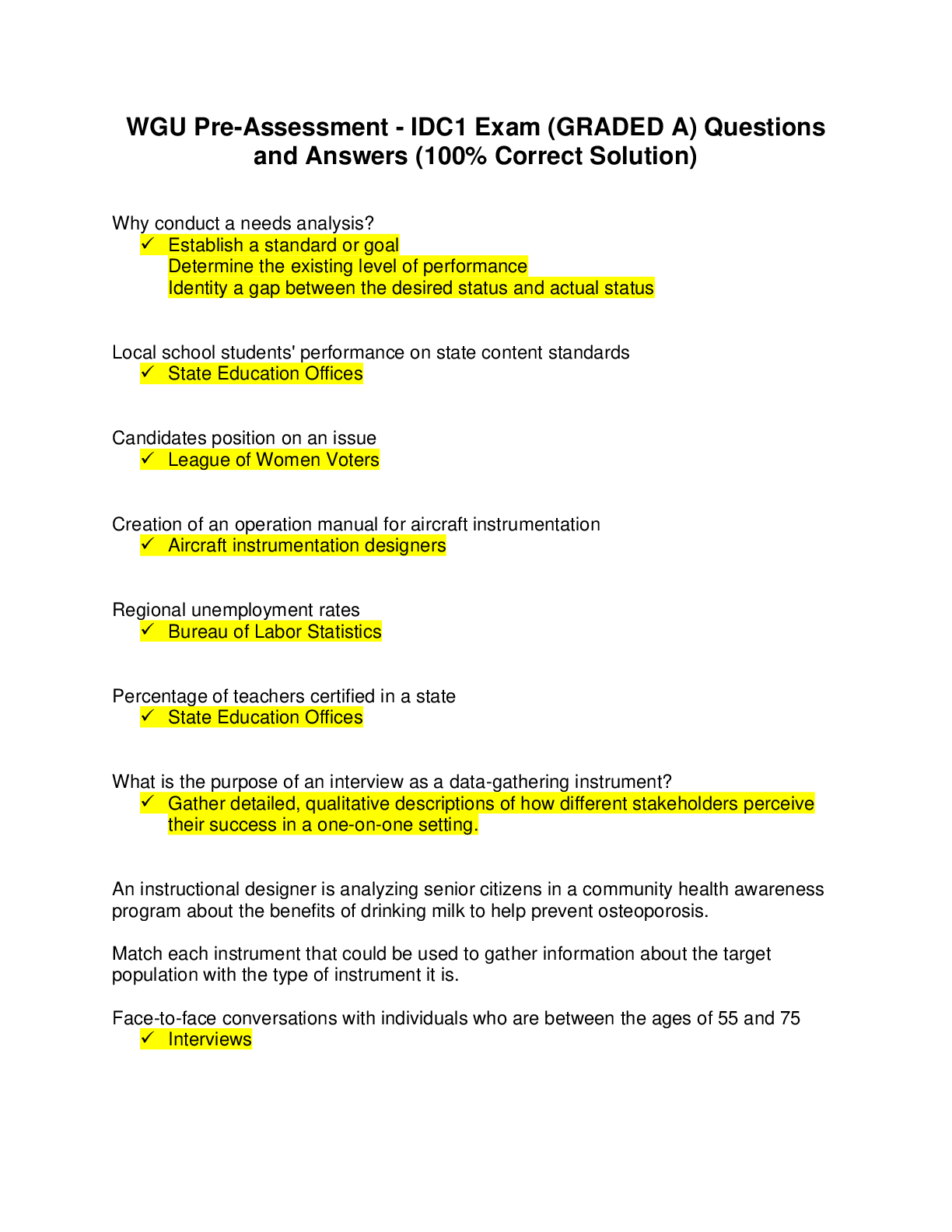NHA PCT Review Guide_ Verified Answers (100% solution guide) .
Document Content and Description Below
NHA PCT Review Guide_ Class 2022. A CPCT should recognize that which of the following scenarios requires an aseptic dressing change? -changing the surgical wound dressing of a patient 1 day post... -op -changing a patient's triple lumen catheter dressing -changing the dressing of a patient who has a deep wound drain -changing the dressing of a patient who has a superficial decubiti When observing a patient's skin integrity, a CPCT should recognize that the first sign of breakdown is -hematoma -redness -melanoma -cyanosis While working with the automated Laboratory Information System, correct input of data is most critical because incorrect data may -cause a system error -be reported to the health care provider -lead to a quality assurance issue -remain in the patient file indefinitely A CPCT is caring for a patient who has an order for tobramycin (Tobrex) level to be drawn 1 hr after dose. The medication has been ordered for 1100. Which of the following actions should the CPCT take? -draw the blood at 1100 -check with the nurse -check with the laboratory -ask the patient Before applying wrist restraints to a patient, a CPCT should take which of the following actions? -check with the nurse for restraint order -measure the patient's blood pressure -measure the patient's 02 saturation -drain the patient's foley catheter A CPCT is measuring a patient's blood pressure. The CPCT should recognize that which of the following situations could result in an inaccurate reading? -the cuff deflates too quickly -the cuff inflates too quickly -the arm is lower than the heart -the arm is at the level of the heart A CPCT is caring for a new patient. Which of the following procedures should the PCT recognize as requiring aseptic technique? -patient identification -documentation -waste management -intact skin care Identify the arrhythmia in the tracing below. -junctional tachycardia -ventricular tachycardia -sinus tachycardia -accelerated idioventricular rhythm Which of the following is a consequence of mislabeling a blood bank specimen? -a HIPAA violation -a transfusion reaction -a medical transcription error -a pharmaceutical reaction Which of the following statements made by a CPCT, regarding preparation of a peripheral blood smear, indicates the need for further teaching? -"I will press down on the spreader slide to fix the cells on the lower slide." -"I will make sure the drop of blood is spread on the lower slide within seconds." -"My smear should occupy 2/3 of the total slide area." -"My smear should be spread almost to the edges of the slide." A CPCT is caring for several adult patients. Which of the following findings should the CPCT report to the nurse first? -blood pressure 139/88 mm Hg -apical pulse of 84 bpm -respiration rate of 22/min -temperature of 38.5 C (100.5 F) During a stress test, a CPCT notices the patient appears to be hyperventilating. Which of the following is an appropriate course of action for the technician? -administer oxygen to the patient -slow down the test -stop the exercise portion of the test -check the patient's respiratory rate A CPCT is caring for a new patient. Which of the following statments made by the patient indicates a need for further teaching, regarding HIPAA? -"If my mother calls my doctor to ask about my condition, she will have to provide proof of who she is." -"If necessary, my doctor can release my test results at his own discretion." -Because of a language barrier, my provider can share my health information with his interpreter." -"If I am unconscious and need medical attention, my doctor can share my health information with my son." A CPCT is caring for four patients. Which of the following findings should the CPCT report to the nurse? -a patient is identified with polyuria and a blood glucose of 200 mg/dL -a patient is identified with vertigo and a blood glucose of 90 mg/dL -a patient is identified with tinnitus and blood glucose of 70 mg/dL -a patient is identified with fatigue and a blood glucose of 120 mg/dL A CPCT is caring for a patient who is to receive continuous tube feedings. The CPCT should place the patient into which of the following positions? -semi-fowler's -high-fowler's -supine -prone A CPCT is working in a facility when the fire alarm goes off. Which of the following actions should the CPCT take first? -contain the fire by closing all the doors -consult the fire safety routes -announce a code over the intercom system -extinguish the fire A CPCT is drawing five blood collection tubes. When should the tourniquet be released? -after the draw is complete -after the last tube -1 to 2 min -3 to 4 min Which of the following procedural steps for a finger stick should the CPCT do first? -cleanse the site with an antiseptic wipe -select the appropriate part of the third or fourth finger -position the blade of the lancet across the lines of the fingertip -confirm the correct identify of the patient Which of the following findings should a CPCT report to a nurse? - 1-year-old patient w/pulse of 50 bpm - 12-year-old patient w/pulse of 76 bpm - 40-year-old patient w/pulse of 88 bpm - 89-year-old patient w/ pulse of 85 bpm A CPCT is assisting with the care of a patient who is receiving a blood transfusion. Which of the following vital signs should the CPCT report first? -a drop in blood pressure -an elevated blood pressure -an elevated temperature -a drop in temperature A CPCT is to determine the pulse rate of a patient who has atrial fibrillation. Which of the following methods should the CPCT use? -manually, using the apical area -manually, using the radial artery -electronically, using a pulse oximeter -electronically, using an EKG machine A CPCT informs the nurse concerning swelling at the peripheral IV site. The CPCT should recognize that which of the following is the most likely cause of this finding? -medication reaction -improper positioning -catheter infiltration -constrictive dressing A CPCT should recognize that which of the following agencies ensures safe work environments? -CDC -FDA -OSHA -DOH When a CPCT is distributing laboratory results to ordering physicians, which results have priority? -lead -basal metabolic panel -presurgical -ferritin A patient has difficulty understanding why she needs an ambulatory monitor after having an EKG 48 hr prior. Which of the following is an appropriate explanation by the CPCT? -"An ambulatory monitor records differently than an EKG." -"Your doctor wants to study your heart over a longer period of time." -"It is standard practice to attach an ambulatory monitor shortly after an EKG." -"I cannot discuss why you have to wear an ambulatory monitor. You'll have to discuss that with your doctor." A CPCT is instructed to measure a patient's pulse manually. Which of the following actions should the CPCT take? -locate the radial artery, feel for the pulse with the index and middle fingers, and count pulses felt for one full min -locate the radial artery, and use the thumb to count each pulse felt for one full min -locate the brachial pulse using the thumb, and count pulses felt for 30 seconds and multiply by 2 -place the center of the palm over the patient's chest and count each beat felt for 2 min A CPCT is assisting with the care of a patient who is 8 hr postoperative following repair of a fractured femur. The CPCT is checking vital signs every 4 hr and notices changes in his vital signs. Which of the following values should be reported to the nurse? -36.6 C/99.7 F, 90 BPM, 18 RPM, 126/86 mm Hg -36.5 C/97.8 F, 72 BPM, 18 RPM, 118/74 mm Hg -37.3 C/99.2 F, 95 BPM, 18 RPM, 180/101 mm Hg -37.1 C/98.9 F, 69 BPM, 19 RPM, 116/80 mm Hg A CPCT is drawing blood from a patient and observes red spots. Which of the following is an appropriate action for the CPCT to take? -stop the draw immediately -apply ice to the site -apply more pressure to the site -release the tourniquet immediately Two CPCTs are transferring a deceased patient from bed to a morgue gurney. To avoid injury, the CPCTs should use which of the following body mechanics? -roll the patient gently from the bed to the gurney -use a draw sheet to lift the patient -have one tech lift the head, the other lift the feet, and allow the momentum to move the patient -use a hoyer lift to move the body When should the code on glucose cuvettes be compared to the code on the glucometer? -after a new package of cuvettes is opened -when a patient is tested -at the beginning of a shift -following an error code A CPCT should recognize that which of the following statements regarding skin preparation for blood cultures is correct? -"I will cleanse the area with 70% ethyl alcohol." -"I will cleanse the area with sodium hypochlorite." -"I will cleanse the area with chlorhexidine gluconate." -"I will cleanse the area with sterile saline." A CPCT is collecting a urine specimen and accidentally spills it on the floor. Which of the following actions should the CPCT take to clean the spill? -use a clean, dry towel -use a disinfectant that contains bleach -call the hazardous materials team -use a mop with hot, soapy water A technician is performing an EKG in a hospital setting. The patient becomes unresponsive, stops breathing, and does not have a pulse. Which of the following would be the first appropriate step? -place the patient in the recovery position -start chest compressions -perform rescue breathing -retrieve the automated external defibrillator The CPCT is caring for a patient who is unable to void her bladder and is crying in pain. Her attending physician has not yet made rounds and her primary nurse is unavailable. Which of the following actions should the CPCT take? -immediately insert a straight catheter to alleviate the patient's pain -report the patient's pain to the charge nurse -ask another nurse for permission to catheterize the patient -contact the patient's on-call physician A CPCT is caring for a patient who has anxiety during venipuncture. Which of the following should the CPCT recognize as an appropriate response? -perform venipuncture as quickly as possible -explain the procedure before beginning the venipuncture -show the patient the equipment in detail and perform the venipuncture -give the patient an informational brochure and perform the venipuncture A CPCT is caring for a patient who is at risk for skin breakdown. Which of the following products should the CPCT use to prevent skin breakdown? -barrier cream -silver sulfadiazine cream -moisturizing cream -permethrin cream A patient loses consciousness. The EKG tracing reveals ventricular fibrillation. Which of the following should the CPCT do first? -notify the physician of the arrest -call for help and begin CPR -go get automated external defibrillator -administer oxygen The CPCT is to collect a 2 hr PP glucose by dermal puncture. Upon entering the room, she sees the patient pushing away the overbed table with the lunch tray still on it. Which of the following actions should the CPCT take? -ask the patient if he has eaten within the past 2 hr -mark the test as random instead of 2 hr PP -contact the patient's provider -perform the test and mark as 2 hr PP A CPCT is caring for a number of patients following a shift change. Which of the following patients should the CPCT assess first? -a patient who has a temperature of 37.3 C/99.2 F -a patient who is disoriented -a patient who is comatose -a patient who is incontinent An EKG has a 2 mm ST elevation in leads I AVL, V5, and V6. What type of infarction would this represent? -septal infarction -inferior infarction -lateral infarction -posterior infarction Which of the following findings on the tracing below should the CPCT be most concerned with? -the irregular rhythm -the ST segment elevation -the QT interval -the variable shape of the P waves A CPCT is caring for an adult patient who has a new prescription for albuterol sulfate (Albuterol) to be administered via an inhaler. Which of the following statements by the patient indicates a need for further teaching? -"As an adult, I don't need to use spacers with my inhaler." -"I will shake the inhaler prior to each use." -"I should stand or sit up straight before using the inhaler." -"I need to breathe in slowly and deeply while using the inhaler." To prevent any needle sticks during venipuncture, OSHA guidelines require -recapping needles -disposing of needles in a sharps container -wearing gloves -emptying sharps container when it is full Which of the following actions is appropriate when labeling specimens? -labeling specimens at the time of collection in front of the patient -specifying the patient's room number, last name, and date of birth on the label -keeping the specimens in the tray and labeling them in the laboratory -writing the CPCT's initials and the time on the label prior to collection A CPCT is obtaining a patient's apical pulse. The CPCT should measure this pulse at which of the following locations? -the 1st intercostal space -the 5th intercostal space -the 7th intercostal space -the 10th intercostal space Which of the following EKG findings differentiates accelerated idioventricular rhythm from junctional rhythm? -accelerated idioventricular rhythm has P waves -the ventricular rate in accelerated idioventricular rhythm is slower than junctional rhythm -junctional rhythm has P waves -accelerated idioventricular rhythm has wide QRS complexes A CPCT is taking a patient's pulse oximetry reading. The CPCT cannot get the reading to appear on the monitor. Which of the following could be the cause? -the patient is running a fever of 38.5 C/101.4 F -the patient has a BP of 84/62 mm Hg with cold hands and fingers -the patient was elevated in semi-Fowler's position, with a cold pack on her forehead -the patient's skin appears flushed When collecting multi-draw venous sample, which of the following sites should the CPCT attempt to draw from first? -median cubital -basilic -cephalic -radial Which of the following occurs in the tracing below? -fusion beat -premature junctional complex -premature ventricular complex -premature atrial complex A CPCT is caring for a patient with congestive heart failure. Which of the following findings should be reported to the nurse immediately? -changes in appetite and food preferences -swelling in the legs and feet -a weight loss of 1 lb in 3 weeks -increased urinary output A CPCT is assisting with the care of a patient who has diabetes mellitus. The CPCT should know that which of the following is a sign of hyperglycemia? -cool, clammy skin -fever -frequent urination -rapid, shallow respirations A CPCT is preparing to draw blood from a patient in a hospital. The patient extends his arm and turns his head away. Which of the following forms of consent does this indicate? -informed consent -expressed consent -refusal of consent -implied consent A CPCT observes that a patient has a productive hacking cough. She offers the patient the emesis basin and tissues. On visualization, the CPCT notices streaks of red-tinged sputum. Which of the following actions should the CPCT take? -advise the patient to do deep breathing exercises -report to the nurse that the patient is expectorating blood -ask the patient what he ate or drank last -offer the patient water to help with sputum production The choice to perform a capillary puncture is best determined by which of the following factors? -patient weight -patient diagnosis -test results -test ordered A CPCT should recognize that a patient must avoid deep-breathing and coughing exercises after which of the following surgeries? -heart surgery -knee-replacement surgery -illeostomy surgery -eye surgery A CPCT is caring for a patient who is to undergo a blood transfusion. The CPCT should recognize that which of the following vital signs should be reported to the nurse immediately? -respiration is 17/min -blood pressure is 139/89 mm Hg -pulse is 85 BPM -temperature is 102 F Industry standard states that needle insertion in the antecubital area should be at a - 5-10 degree angle - 15-30 degree angle - 40-45 degree angle - 50-60 degree angle Which of the following arrhythmias is represented in the tracing below? -ectopic atrial tachycardia -wandering atrial pacemaker -atrial premature contraction -atrial fibrillation A CPCT is collecting a stool specimen from a newly admitted patient. The CPCT should recognize that which of the following findings could be a sign of an upper gastrointestinal disorder? -green stool -red stool -black, tarry stool -yellow, runny stool A CPCT is preparing to transfer a nonambulatory patient from a bed to a wheelchair. Which of the following steps should the CPCT take? -place the patient into a prone position -applying transfer belt with the buckle in the rear -locking the wheels of the wheelchair and the bed -allowing the patient to transfer without assistance A CPCT is to perform a venous blood draw on a 91-year-old patient. The CPCT should use which of the following methods? -butterfly needle and syringe -hand draw -capillary collection -vacutainer collection The CPCT has orders to collect blood cultures, CBC, PTT, and an iron panel. He forgets to draw for the PTT. Which of the following actions should the CPCT take? -discard the specimens and redraw -keep the specimens collected and draw the PTT -call another CPCT and notify the supervisor -draw a discard tube and redraw blood cultures and blue top A CPCT is providing palliative care to a patient. The patient's family expresses feelings of anger and hopelessness. Which of the following actions should the CPCT take? -explain that anger is the first coping mechanism everyone experiences during grief -refer the family to the charge nurse -recommend that the patient talk to social services -listen when the family is ready to talk A CPCT is in the cafeteria during lunch. A visitor appears to be in respiratory distress. The visitor's lips and tongue are swollen. Which of the following actions should the CPCT take? -perform the abdominal thrust maneuver -ask the person if she has any allergies -get the defibrillator and call a code red -palpate the pulse and begin CPR A CPCT should recognize that a chain of custody is used for which of the following reasons? -to follow methods of collection with samples and data -to guarantee the identification and integrity of samples -to ensure that samples are being disposed of using correct operating procedures -to track the location of samples and data A patient presents alert and oriented, but a CPCT finds that all the waveforms are negative in Lead I. The technician should check the cable connections for which of the following limb electrodes? -L leg and R leg -L arm and L leg -R arm and L leg -R arm and L arm A CPCT is manually transferring a patient who has a right-side weakness from the bed to a wheelchair. Which of the following methods should the CPCT use to promote proper body mechanics? -have the patient wrap her arms around his neck, bend at the waist, and lift using his back muscles -have the patient hold his hand, stand using weak side first, while he supports the patient's strong side -ask the patient to lean backward in the bed, grasp front of transfer belt, pull up and transfer into wheelchair -grasp back of the transfer belt, have patient stand using stronger side while lifting with legs and keeping back straight A CPCT is collecting a patient's sputum specimen. Which of the following actions by the CPCT is contraindicated? -instructing the patient to cough deeply -collecting at least one teaspoon of sputum -having the patient use an alcohol-based mouthwash -obtaining a specimen at 0700 Some older-adult or obese patients may not have accessible antecubital veins. In this situation, the CPCT may use which of the following? -dorsal veins -superficial veins -wrist veins -foot veins A CPCT is assisting a patient to take self-administered medications. The CPCT should recognize that which of the following medications should not be crushed? -scored tablet -enteric-coated -intradermal -parenteral Which of the following is the best method to prevent internal or external bleeding from the venipuncture site after the needle is removed? -apply pressure to prevent leakage of blood into the tissues -have the patient bend the arm at the elbow to reduce bleeding -apply a hot pack to the site if swelling or discoloration occurs -apply a cotton ball to the site During a routine venipuncture, the patient becomes pale and diaphoretic. What condition is most likely to occur in this patient? -syncope -seizure -nausea -shock A CPCT makes a mistake while measuring a patient's blood pressure. Which of the following actions should the CPCT take? -partially deflate the cuff and then reinflate it -release all of the air from the cuff before retesting -measure the blood pressure using a different arm -measure the blood pressure using a different cuff A CPCT is transferring a patient using a Hoyer lift from a bed to a wheelchair. As the patient is being transferred, the CPCT should place him into which of the following positions? -sims -fowler's -lithotomy -trendelenberg's A CPCT detects a U wave, and a patient reports chest pain and discomfort. Which of the following is an appropriate action for the technician to take? -reposition the patient's chest electrodes -perform another EKG recording -notify the patient's physician -check the patient and the room for causes of artifact interference A CPCT must invert anticoagulant tubes to prevent which of the following? -hemolysis -clotting -hemoconcentration -reflux A CPCT is assisting in the care of a patient who has a wound left to heal by way of granulation. How often should this wound be redressed? -every 4 hr -every 8 hr -every 12 hr -every 24 hr A CPCT is caring for a patient who has hepatitis B. Which of the following precautions should the CPCT take? -droplet -reverse isolation -standard -enteric Which of the following actions should a CPCT take when discharging a patient? -review self-care procedures with the patient's family -inform the patient of any follow-up appointments -answer any questions regarding medications -escort the patient using a wheelchair The CPCT needs to draw a GTT on a patient and notices an empty breakfast plate on the bedside table. Which of the following actions should the CPCT take? -ask the patient if he has had anything to eat or drink -collect the specimen as ordered -delay performing the draw for 4 hr -write on the requisition form that the patient has not fasted A CPCT is caring for a patient whose daughter is visiting. The daughter asks about the health of the patient's roommate. Which of the following statements by the CPCT is an appropriate response? -"I'll get the nurse." -"You can ask the patient about his condition." -"I'll send a request to the medical records department." -"I need you to fax over a written request." A CPCT is assisting with the care of a patient who is on strict I&O. How often should the CPCT record the patient's I&O? -every 1 hr -every 2 hr -every shift -every day Which of the following actions should the CPCT take when preparing to transfer a patient from a bed to a stretcher? -elevating the bed to a position equal to the height of the stretcher -elevating the bed to a position lower than the height of the stretcher -reaching across the stretcher to assist the patient -elevating the bed to a position higher than the height of the stretcher A CPCT is preparing a patient for hospital discharge. The patient states, "I'm afraid to go back home to my husband." Which of the following responses by the CPCT is appropriate? -"Would you like to speak with a police officer?" -"If your husband is abusing you at home, would you tell me immediately?" -"Your husband loves you, and you have no reason to be afraid." -"Can you tell me if something happened that made you feel unsafe?" The CPCT is monitoring a patient who has severe hypertension. Which of the following findings related to the patient's condition should the CPCT report to the nurse immediately? -the patient complains of stiffness in his hands and feet -the patient needs help lifting his legs onto the bed -the patient's lower limbs show pitting edema -the patient's fingers are thick and flat A CPCT is planning care for a patient who is on contact precautions. When entering the patient's room, the CPCT should apply which of the following? -surgical mask -N95 respirator -gown -shoe covers The atypical vertical projections in the EKG below are likely the result of which of the following? -pacemaker spikes -intrinsic R waves -intrinsic vertical anomaly -defibrillator spikes Using the image below, localize the area of injury. -anterior wall -low lateral wall -inferior wall -high lateral wall Which of the following tubes should be collected first for dermal samples? -lavender top -green top -red top -light blue top A CPCT is performing ostomy care for a patient. Which of the following findings should the CPCT report to the nurse? -the stoma has a small amount of bloody drainage -the stoma is red in color -the stoma is leaking around the wafer -the stoma remains the same size A CPCT is caring for a patient who had a CVA and is nonambulatory. Which of the following findings should the CPCT report to the nurse immediately? -redness that subsides with repositioning -continued loss of feeling in one extremity -one episode of incontinence -change in size and shape of pressure ulcer A CPCT is changing a patient's bedding and is accidentally stuck with a needle. Which of the following actions should the CPCT take first? -visit the occupational health facility -complete an incident report -milk the affected site -report the incident to her supervisor What action should the CPCT take to verify the quality of venipuncture supplies before beginning a blood draw? -determine that the tourniquet is the proper size -check the vacuum of the tube -inspect the integrity of the needle's seal -verify that the adapter is the correct color A CPCT is caring for a patient who is nonambulatory. Before manually lifting the patient, which of the following factors should the CPCT consider first? -the patient's ability to assist -the patient's height and weight -the patient's monitor cables -the patient's skin integrity Which of the following abnormalities is associated with large U waves on the EKG? -increased sodium level -increased potassium level -decreased sodium level -decreased potassium level A CPCT observes a hematoma developing at the site of a venous blood draw. The CPCT should -observe the site to see if the hematoma worsens -ask the patient to apply pressure to the area -release the tourniquet and stop the draw -call for a nurse and assess the patient's condition A CPCT receives orders to draw an infant screening card, O2 levels, bilirubin, and DNA. Which of the following should be drawn first? -02 levels -bilirubin -DNA -screening card A CPCT enters a patient's room and is approached by visitors requesting test results. Which of the following responses by the CPCT is appropriate? -"The doctor needs to give you that information." -"The lab values were all within the expected reference range." -"I'm sorry, but I can't give you that information." -"I'll ask the nurse to give you that information." Identify the rhythm in the tracing below. -multifocal atrial tachycardia -atrial fibrillation -wandering atrial pacemaker -atrial flutter with variable conduction A CPCT is measuring an adult patient's blood pressure electronically. Which of the following readings should be reported to the nurse? -116/78 mm Hg -98/60 mm Hg -135/84 mm Hg -90/50 mm Hg [Show More]
Last updated: 2 years ago
Preview 1 out of 21 pages

Buy this document to get the full access instantly
Instant Download Access after purchase
Buy NowInstant download
We Accept:

Reviews( 0 )
$15.00
Can't find what you want? Try our AI powered Search
Document information
Connected school, study & course
About the document
Uploaded On
Apr 16, 2022
Number of pages
21
Written in
Additional information
This document has been written for:
Uploaded
Apr 16, 2022
Downloads
0
Views
224












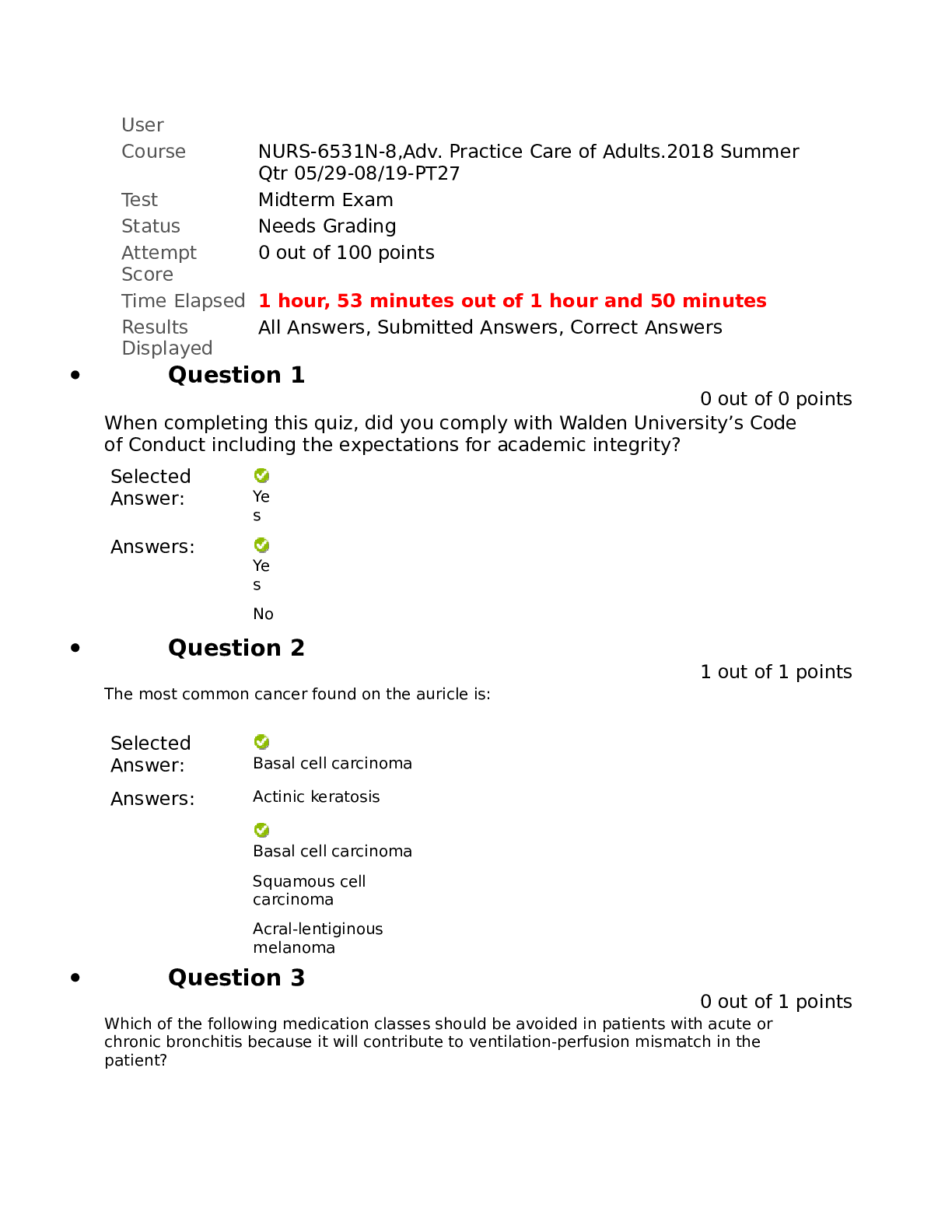
 (1).png)
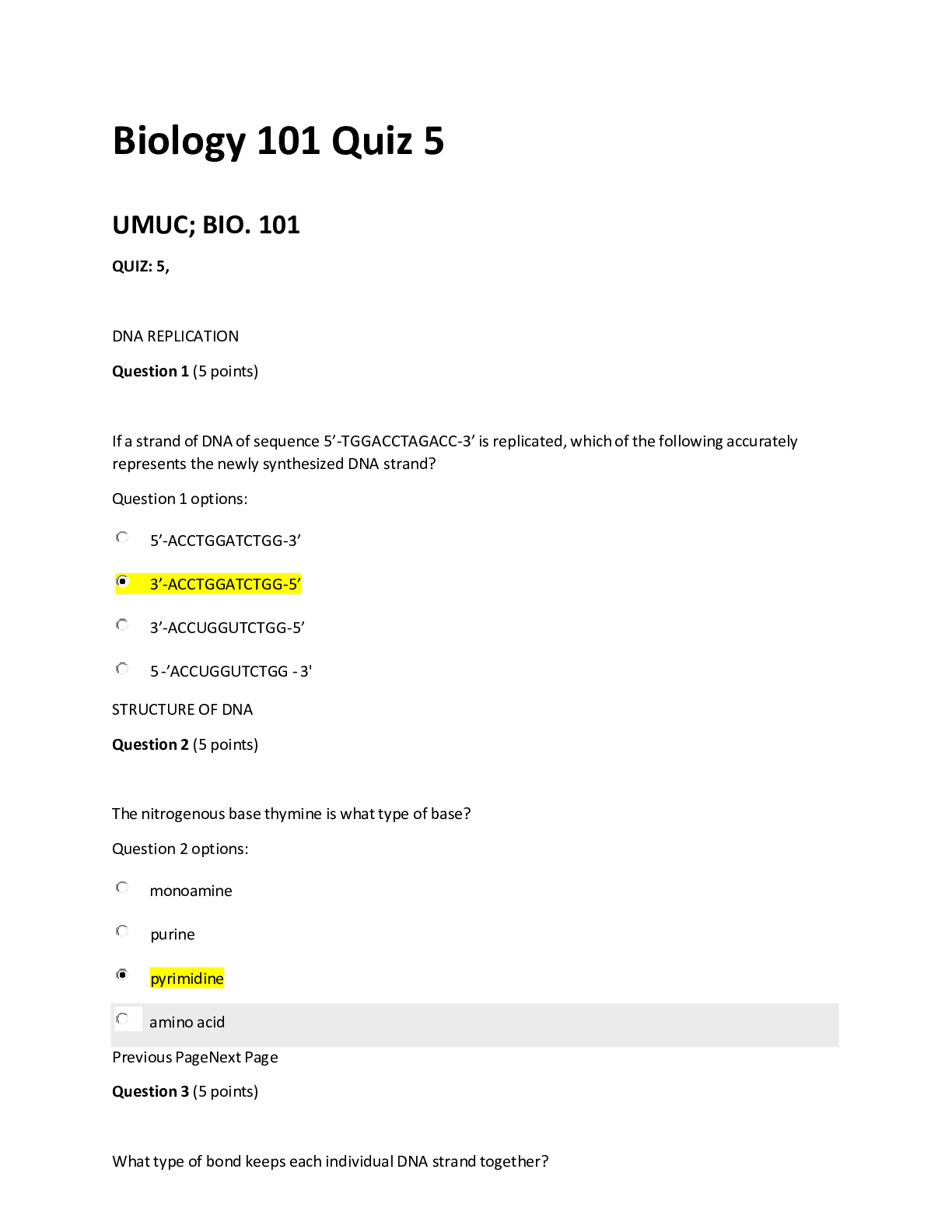
.png)

